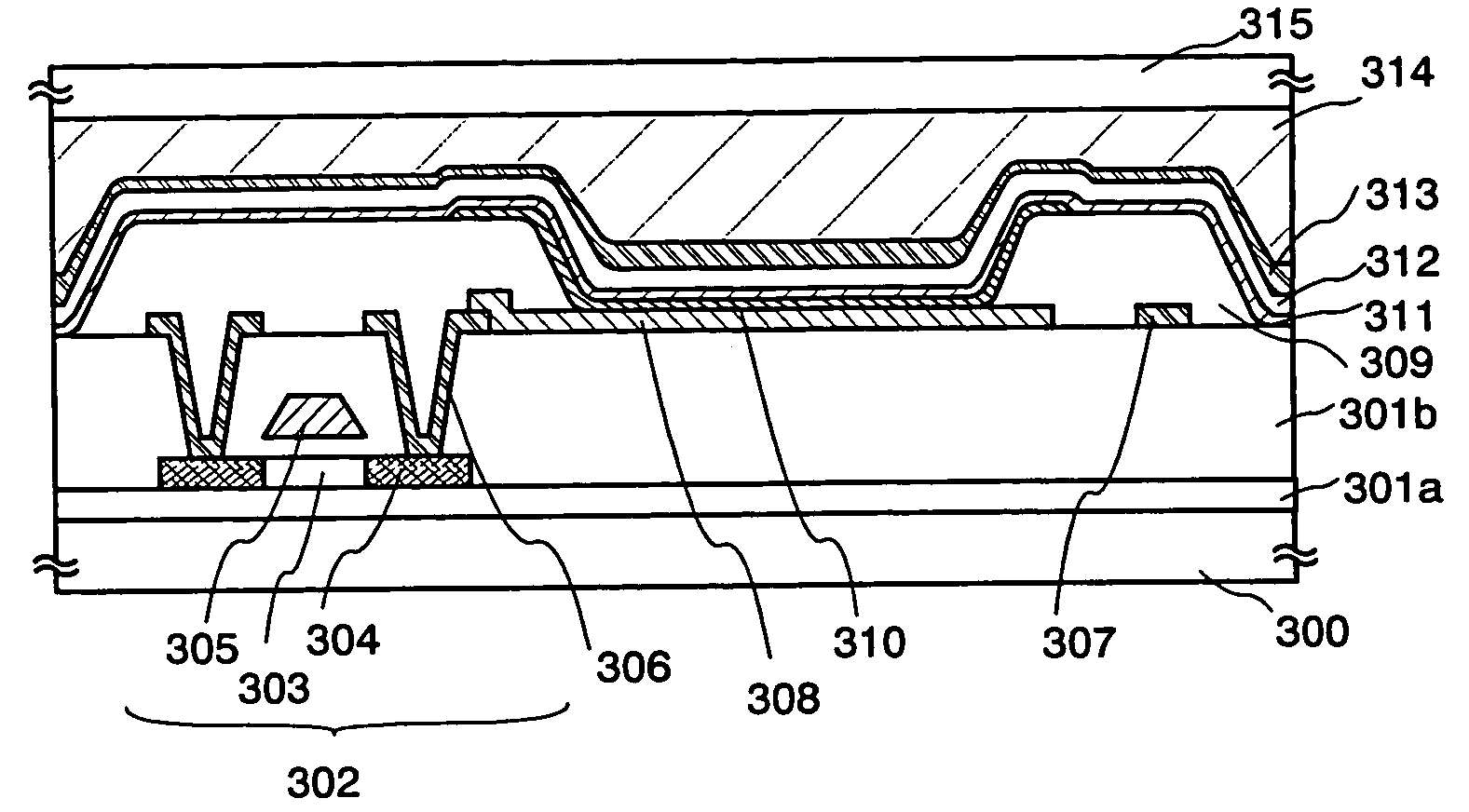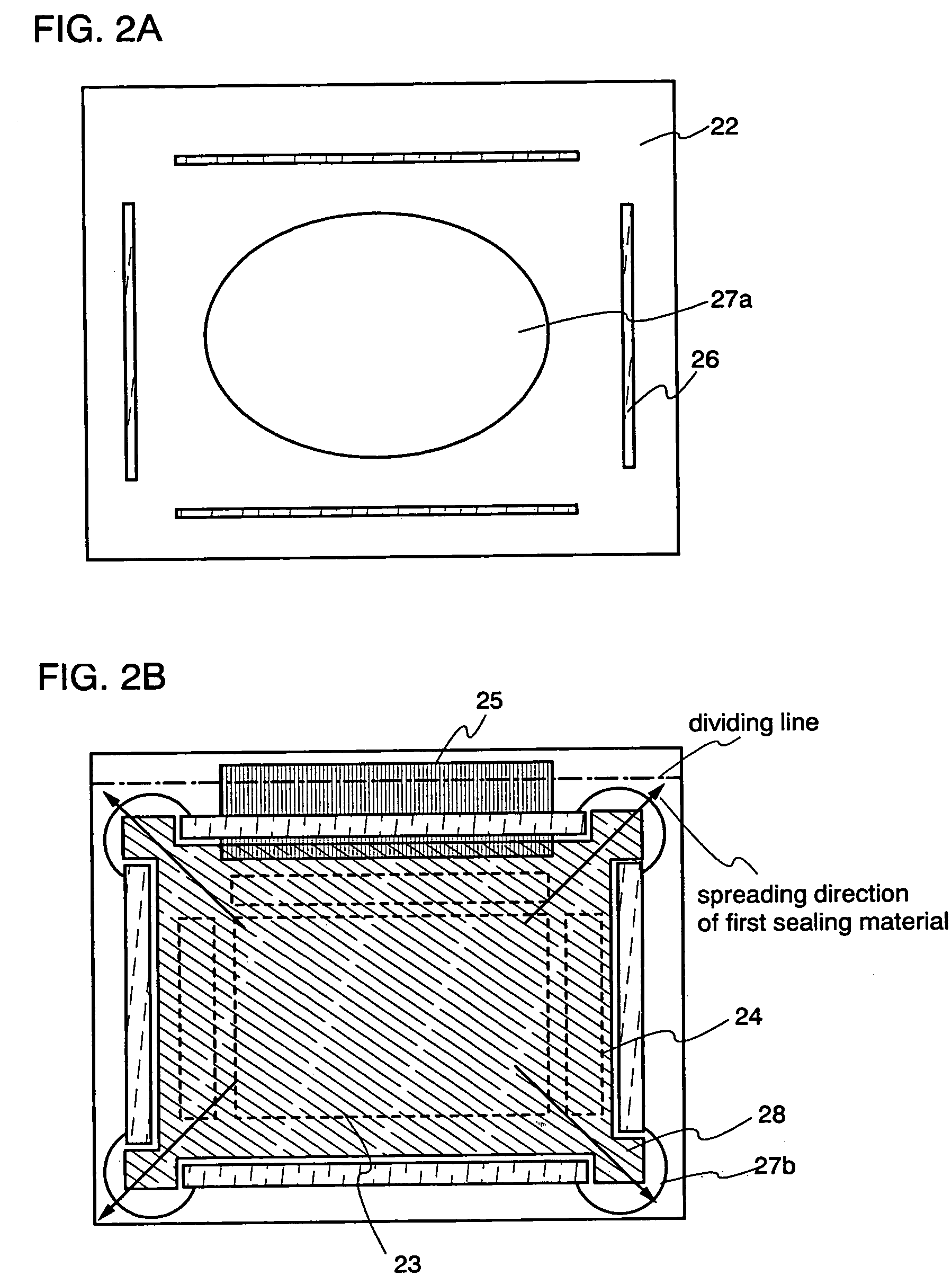Method for manufacturing light-emitting device
a technology of light-emitting devices and manufacturing methods, which is applied in the manufacture of electrode systems, electric discharge tubes/lamps, discharge tubes luminescnet screens, etc., can solve the problems of deterioration of the el layer, short life of light-emitting elements, and easy oxidation or absorption of moisture, so as to prevent oxygen or moisture, enhance reliability, and prevent the effect of deterioration of light-emitting elements
- Summary
- Abstract
- Description
- Claims
- Application Information
AI Technical Summary
Benefits of technology
Problems solved by technology
Method used
Image
Examples
embodiment mode 1
[Embodiment Mode 1]
[0075]FIG. 1A is a top view of an active matrix light-emitting device according to the present invention.
[0076]In FIG. 1A, reference numeral 11 denotes a first substrate, reference numeral 12 denotes a second substrate, reference numeral 13 denotes a pixel portion, reference numeral 14 denotes a driver circuit portion, reference numeral 15 denotes a terminal portion, reference numeral 16 denotes second sealing materials, reference numeral 17a denotes a first sealing material, and reference numeral 18 denotes a catalyst for curing the first sealing material.
[0077]There are no specific limitations placed on the material used for the first substrate 11. It is preferable, however, to use substrates having identical thermal expansion coefficients for the first substrate 11 and the second substrate 12 because the two substrates are bonded together. A substrate having light transparency, for example, a glass substrate, a quartz substrate, or a plastic substrate, is used ...
embodiment mode 2
[Embodiment Mode 2]
[0091]A portion of a cross sectional structure of a pixel portion of the present invention is shown here in FIGS. 3A to 3C.
(First Substrate)
[0092]In FIG. 3A, reference numeral 300 denotes a first substrate, reference numerals 301a and 301b denote insulating layers, reference numeral 302 denotes a TFT, reference numeral 308 denotes a first electrode, and reference numeral 309 denotes an insulator. Reference numeral 310 denotes an EL layer, reference numeral 311 denotes a second electrode, reference numeral 312 denotes a transparent protective layer, reference numeral 313 a catalyst layer, reference numeral 314 denotes a first sealing material, and reference numeral 315 denotes a second substrate.
(TFT Structure)
[0093]The TFT 302 (p-channel TFT) formed on the first substrate 300 is an element for controlling current flowing in the light-emitting EL layer 310, and reference numeral 304 denotes a drain region (or a source region) thereof. Further, reference numeral 306...
embodiment mode 3
[Embodiment Mode 3]
[0114]A case of forming a plurality of pixel portions on one substrate, that is, an example of multiple patterns, is shown in FIGS. 4A to 4E. An example of forming four panels using one substrate is described hereinafter.
[0115]Second sealing materials 32 are formed in a predetermined location on a second substrate 31 by a dispenser in an inert gas atmosphere (FIG. 4A). A material that contains a filler (diameter 6 μm to 24 μm) and has a viscosity of 370 Pa·s is used as a material for the semi-transparent second sealing materials 32. The second sealing material 32 can be formed by a printing method because it has a simple sealing pattern.
[0116]Next, a transparent first sealing material 33 is dripped on the region surrounded by the second sealing materials 32 (with openings in four corners) (FIG. 4B). A highly heat resistant UV epoxy resin added with a photo-oxidation generating material (product name: 2500 Clear, manufactured by Electrolite Cooperation) having an i...
PUM
 Login to View More
Login to View More Abstract
Description
Claims
Application Information
 Login to View More
Login to View More - R&D
- Intellectual Property
- Life Sciences
- Materials
- Tech Scout
- Unparalleled Data Quality
- Higher Quality Content
- 60% Fewer Hallucinations
Browse by: Latest US Patents, China's latest patents, Technical Efficacy Thesaurus, Application Domain, Technology Topic, Popular Technical Reports.
© 2025 PatSnap. All rights reserved.Legal|Privacy policy|Modern Slavery Act Transparency Statement|Sitemap|About US| Contact US: help@patsnap.com



